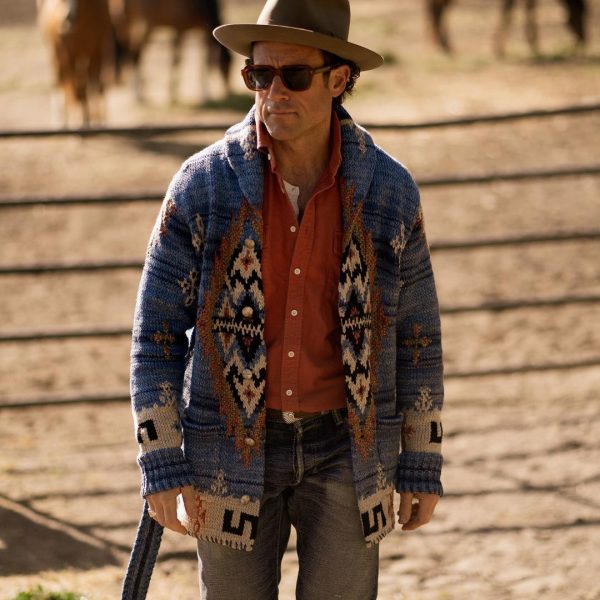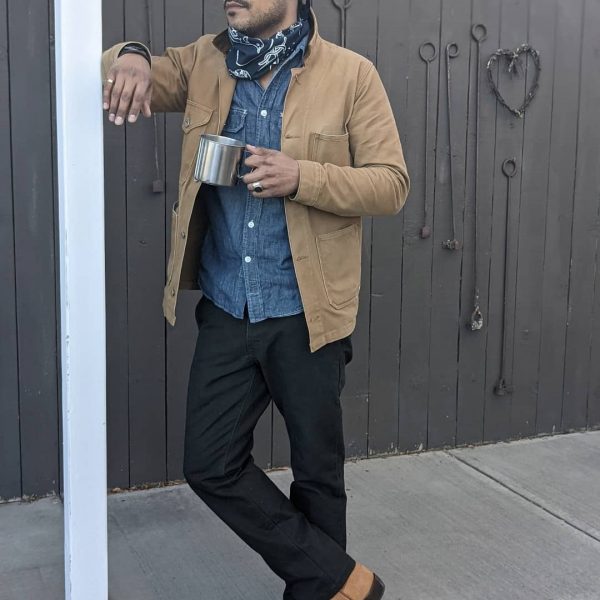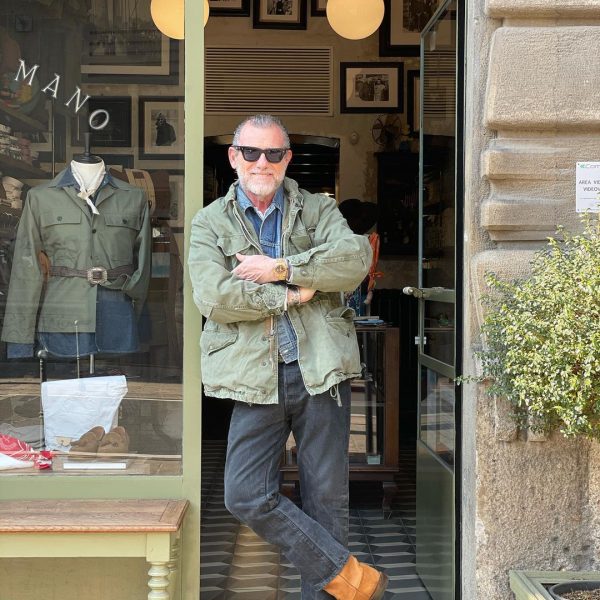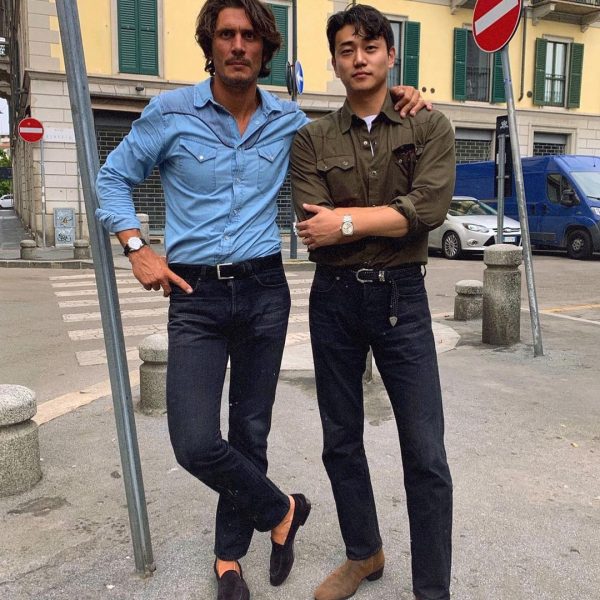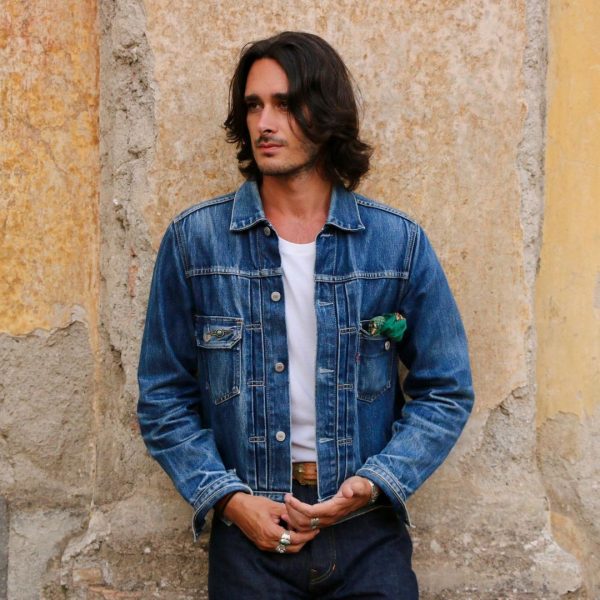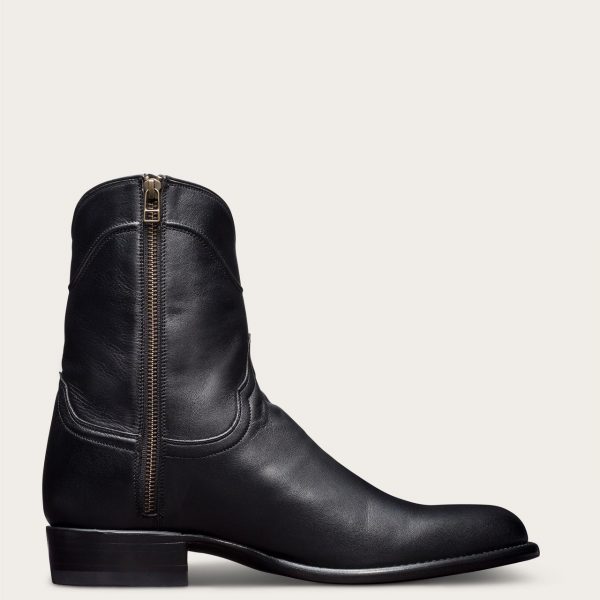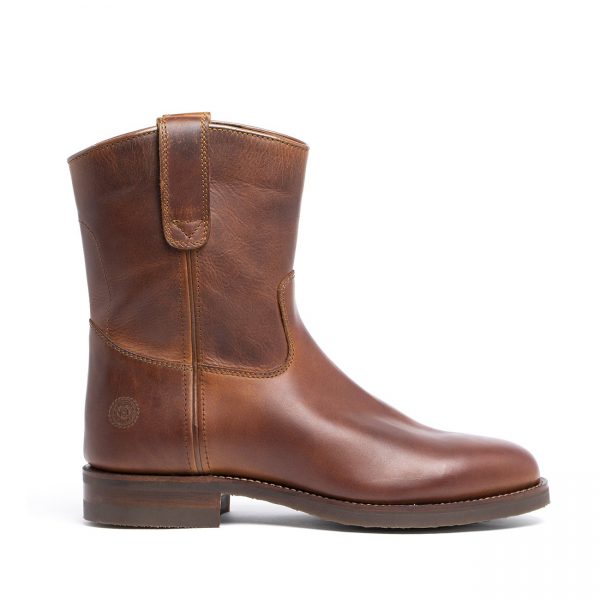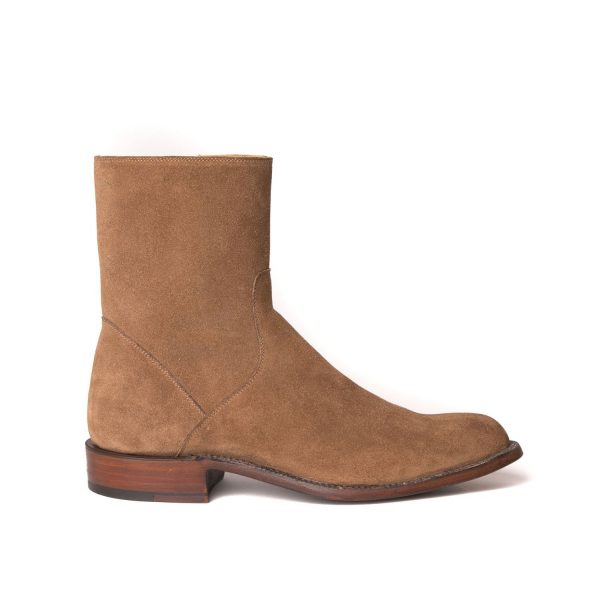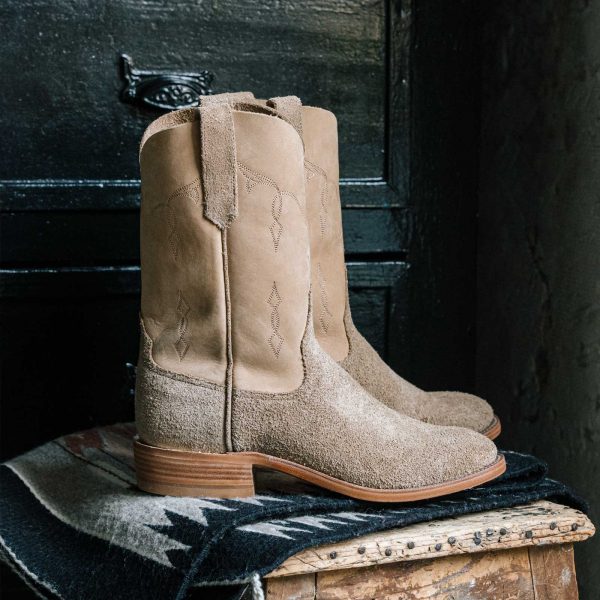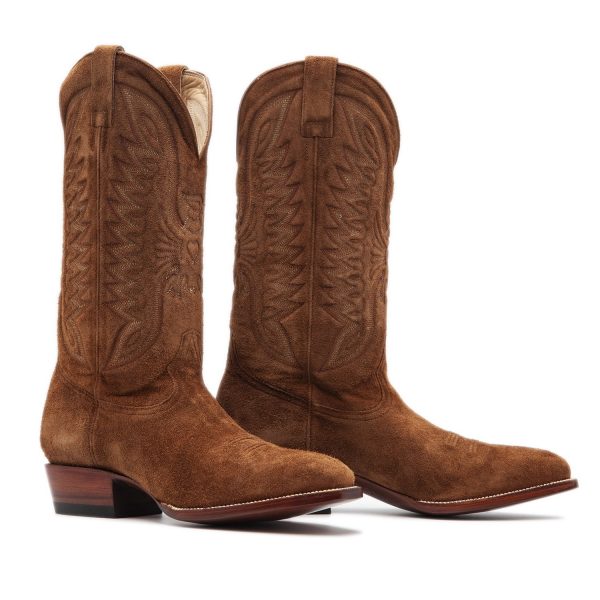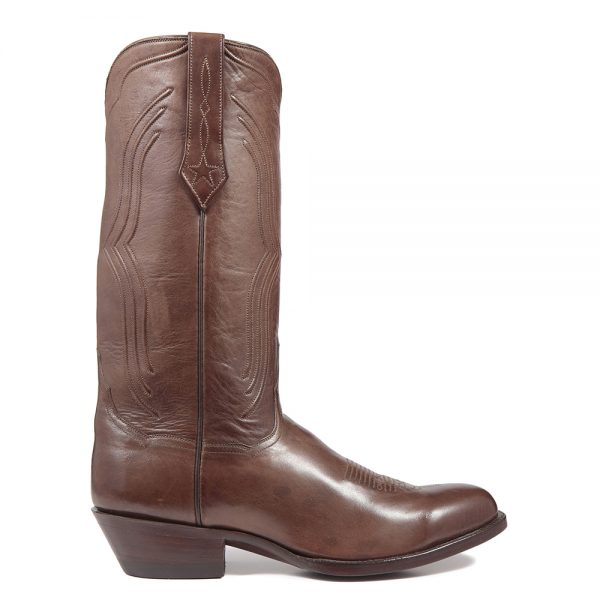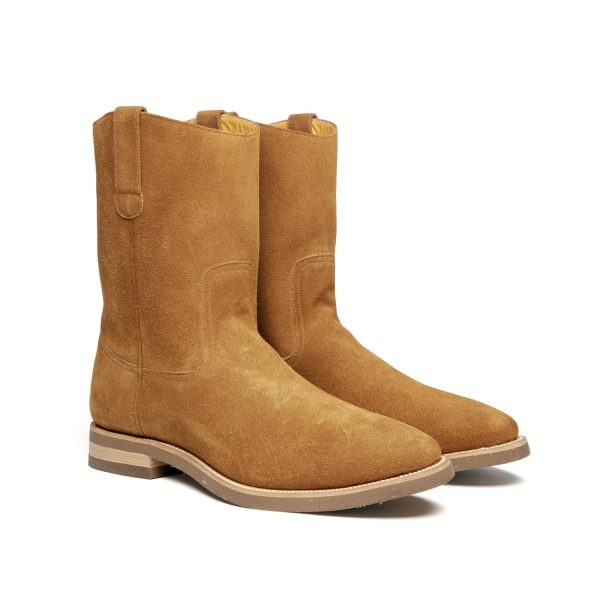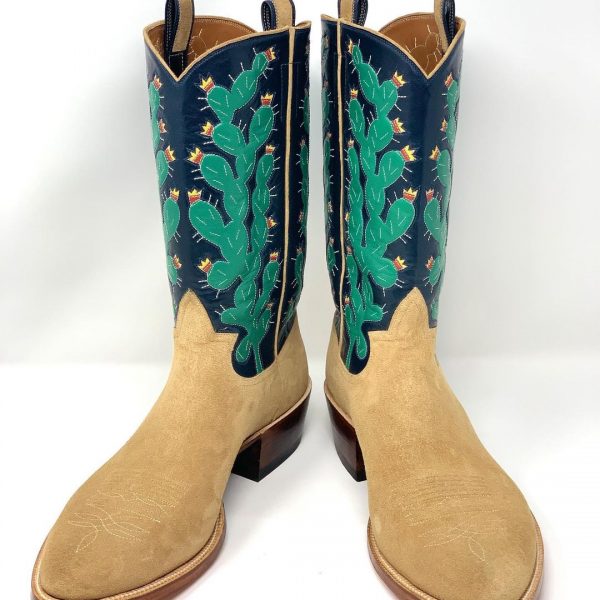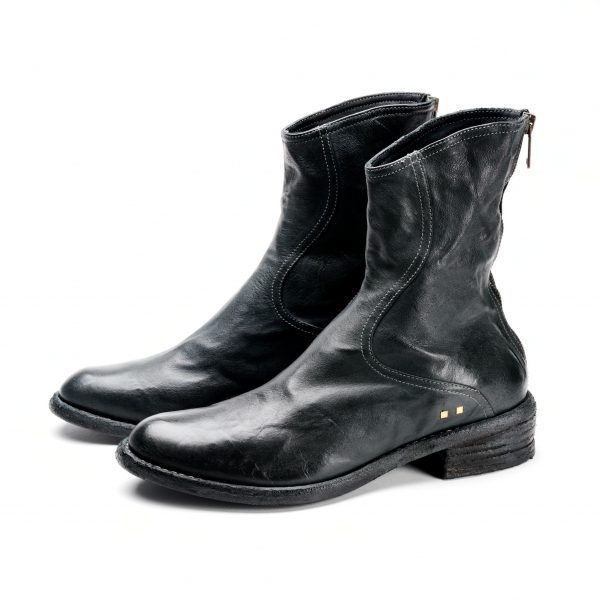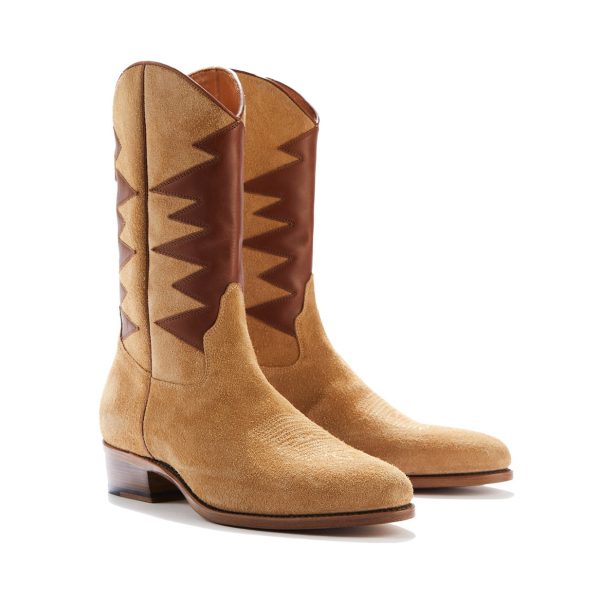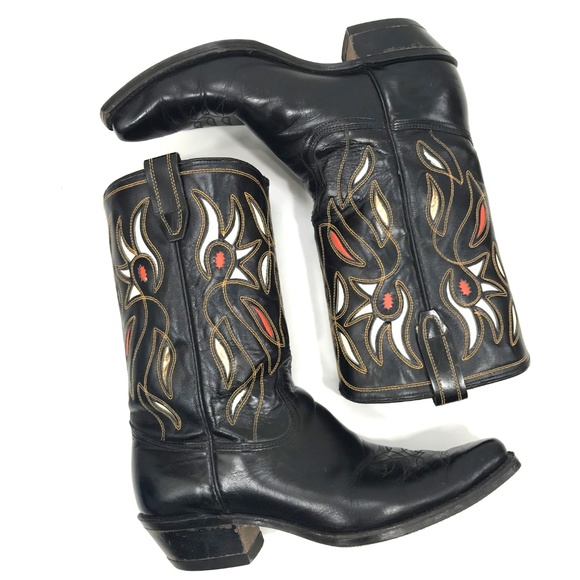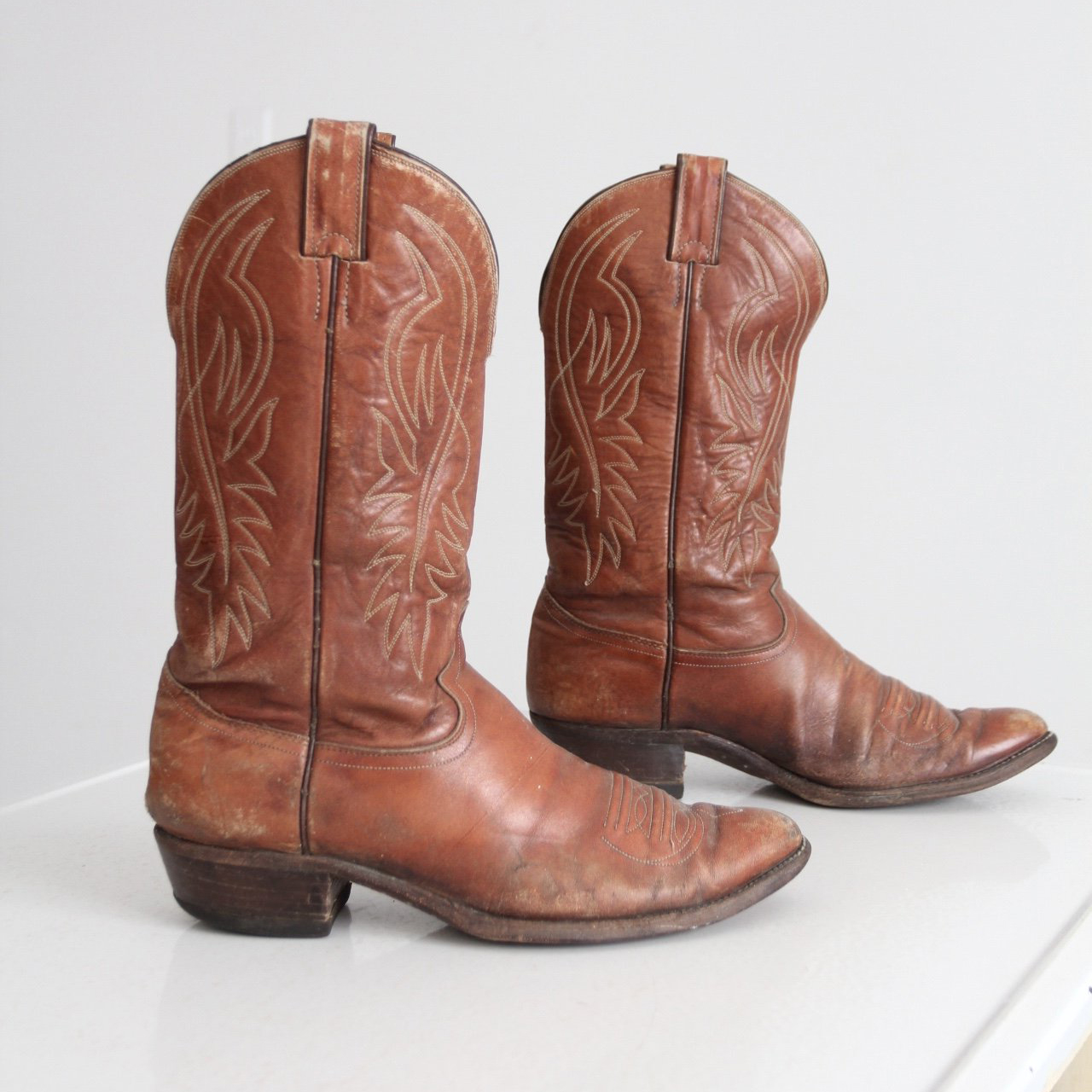
In the late 1960s, the United States was sharply divided in a culture war that Bruce Boyer once characterized as “The Man in the Gray Flannel Suit” versus the “rebel rocker.” The Ivy League Establishment wore sack suits, foulard ties, and polished wingtips, whereas anti-Establishment gravitated towards repurposed Army jackets, Levi’s jeans, and black double riders. These two camps defined themselves as being “not like the other,” and they expressed their values through their dress. However, one thing stretched across the divide. President Lyndon B. Johnson, who held a deep fondness for “rural hill country,” famously wore cowboy boots. According to his press secretary, Bill D. Moyers, the President bought a brand new pair of cowboy boots every week. (Housed in a glass enclosure at the LBJ Museum in Austin, you can find his black alligator boots from Tony Lama, which are decorated with the Presidential seal). During the same period, countercultural, bohemian youths wore cowboy boots with bootcut jeans, crisp white tees, and slimline trucker jackets. Of course, their style wasn’t inspired by LBJ, but rather Dennis Hopper and Peter Fonda, who played cowboy heroes on the silver screen.
In the last few years, Westernwear has been bubbling as a slow, simmering trend, finally reaching a boil in 2020. Daniel Penny, an occasional Put This On contributor, recently wrote an article for the Wall Street Journal, where he credits this revival to the rise of cowboy references in popular culture — shows such as Yellowstone and Westworld, Lil Nas X’s earworm “Old Town Road,” the yeehaw agenda, and Hedi Slimane’s use of fringed jackets, pointy boots, and Western belts in his collections. Even in this context, wearing cowboy boots can feel like you’ve crossed the Rubicon. It’s easy to incorporate other Westernwear items into a classic wardrobe. Denim Western shirts can be worn with tailored tweeds; trucker jackets go with everything from white jeans to olive fatigues. But cowboy boots are so regional and niche; putting on a pair can feel like cosplay if you’re in the city.
Yet, something is appealing about the style. More than natural shouldered suits and oxford button-downs, cowboy boots are closely tied to an American identity. They’re a symbol of self-reliance, resourcefulness, practicality, optimism, and rugged individualism. In the last few years, Westernwear items have slowly crept into my wardrobe: first, with a denim Wrangler shirt I bought in 2016, then an RRL ranch jacket, a vintage Lee 101J, a suede Barbanera trucker, and a couple of more Western shirts in rustic materials such as raw denim and cord. Earlier this year, I finally bought a pair of cowboy boots after eyeing the style for a year. Admittedly, cowboy boots might be one of those things you look back upon and regret (sort of like the 2021 equivalent of double monks). But if it gives traditionalists any comfort, even Alan Flusser owns a few pairs.
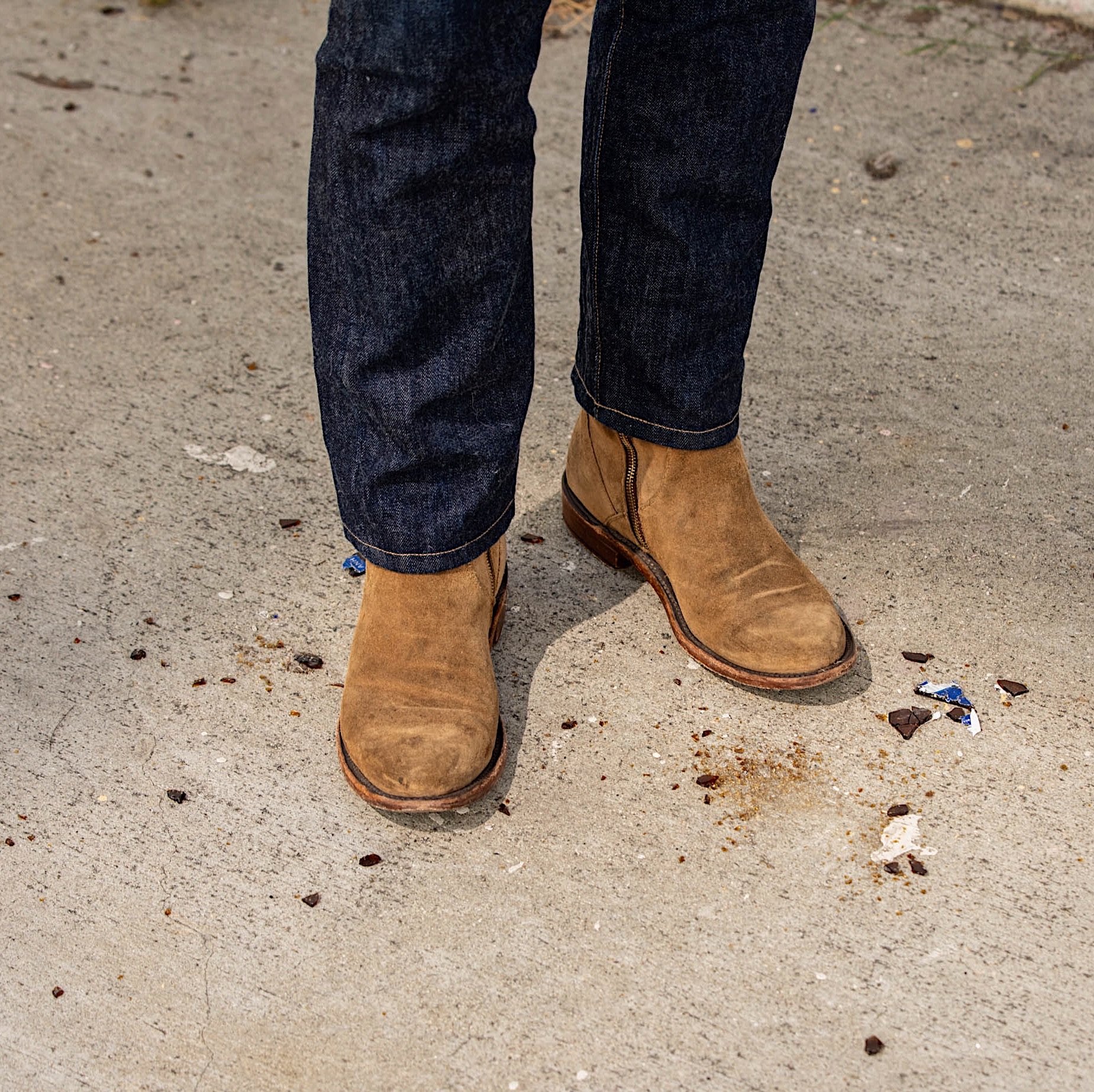
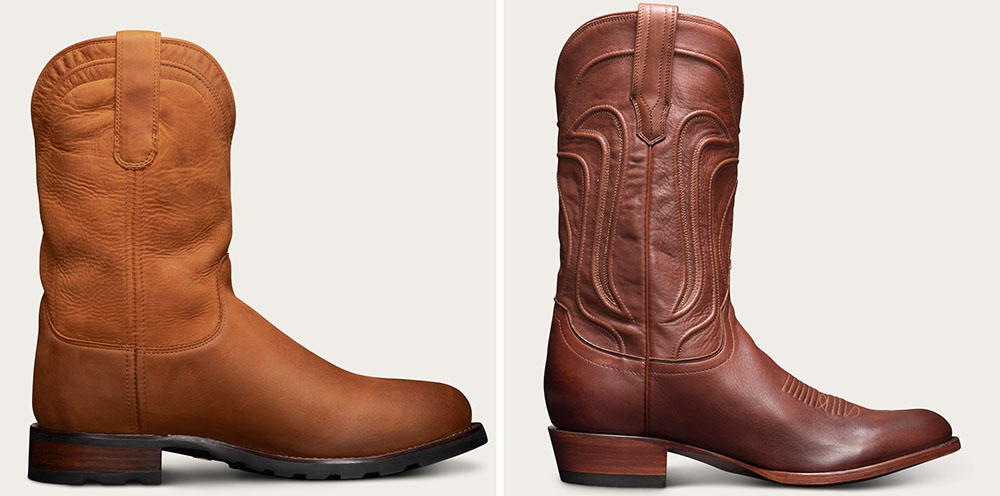
How to Wear Them
Let’s get this out of the way: cowboy boots and Westernwear can be a bit costumey, particularly if they’re not native to your area. But the style can also be on a sliding scale of yeehaw. Much depends on what you’re wearing up top, the accessories, and the specific boots you choose.
Broadly speaking, there are three types of Westernwear boots: cowboy boots, roper boots, and a side-zip style that’s become increasingly popular in Westernwear stores. Cowboy boots are what you imagine when you hear the term “Westernwear.” The style is defined by its high shaft and elevated heel (which was designed so that cowboy and cowgirls could ride “deep in the stirrup”). The shaft is often made with cords, inlays, or decorative stitching, which performs a function other than being ornamental. They hold the tops to the linings without the use of cement. The stitching across the vamp — sometimes called a toe bug, toe flower, or a bug and wrinkle — is also said to be a maker’s signature.
Ropers are a little different. Whereas cowboy boots are designed for horse riding, ropers are designed for, well, people who rope animals. As such, they have a lower heel that gives the wearer stronger footing. Cowboy boots can make you stand taller and straighter, but the higher the heel, the more uncomfortable they feel during long walks (they can make your feet feel a little tired). Ropers, on the other hand, feel like any other boot or shoe in your closet. They also typically have a rounder toe than their cowboy boot counterparts (which are designed to easily slip into the stirrup).
Finally, you have side-zips. Hard-nosed traditionalists will sneer, but side zips have become increasingly common, even among well-respected suppliers such as Lucchese. I find these to be a little different from the side-zip styles you find at fashionable brands such as Buttero and Margiela. They tend to be sleeker and echo the Westernwear styles that occupy the same shelves off which they’re sold. I wear my Margiela side-zips with everything from topcoats to five-zip leather jackets, but my Lucchese side-zips only feel right in certain types of workwear — trucker jackets, CPO naval shirts, and milsurp field coats. Basically, the sorts of things you can imagine being worn in California (more “LA Dude in Levi’s,” less “Maine Guy in LL Bean”).
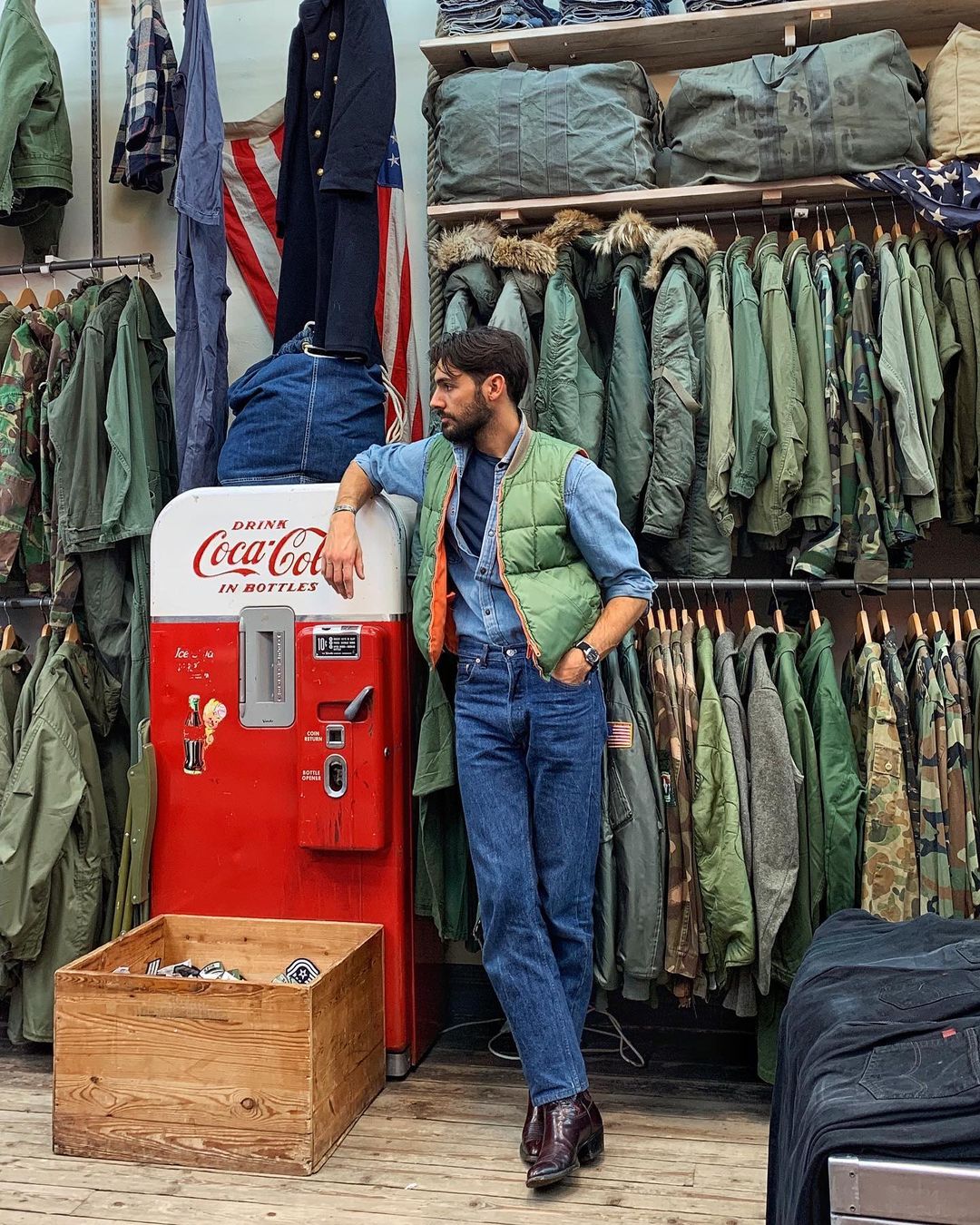
When putting together a Westernwear outfit, consider where you want to sit on the “yeehaw spectrum.” Cowboy boots make the strongest statement, while ropers will feel more like the Blundstones, Red Wings, and Viberg service boots that may already be kicking around in your closet. Side-zips are so barely Western, serious Western boot enthusiasts don’t even consider them part of their dress culture.
In the photos above, you can also see how various outfits occupy different positions on this spectrum. Nathaniel Asseraf of Broadway and Sons is shown wearing a fairly standard workwear uniform — blue jeans, washed denim shirt, indigo tee, and a quilted puffer jacket — that’s made Western simply because of his cowboy boots. Alessandro Squarzi of Fortela wears an olive field jacket with a denim trucker, some faded black jeans, and a pair of toned-down ropers. I find ropers to be a bit more versatile — they go with almost any outfit where you can imagine a pair of standard work boots — while cowboy boots make a statement.
The other outfits also have very different expressions. Peter Zottolo is wearing perhaps the most “yeehaw” outfit with his RRL cardigan, Taylor Stitch chamois shirt, Stike Gold jeans, and Wellema hat. Although he’s at a horse ranch in that photo, I think the outfit would still look at home in the city. Alternatively, you can tone things down with something like Charlie’s all-black outfit, which has a more rock ‘n roll vibe, or CJ Cook’s chore coat ensemble (CJ has a Youtube channel, where he reviews workwear boots, including many Western styles). Eric Kim’s Western shirt and Raphaël’s trucker jacket outfits are so barely Western, you wouldn’t blink an eye if you saw these in downtown San Francisco. You can also imagine a pair of Western boots with David Evans’ outfit on Instagram — a pair of white jeans with a blue denim trucker jacket and a chambray shirt. The combo is so common and classic, you’d struggle to call it Westernwear at all.
Choose cowboy boots if you want to make a statement, ropers if you want something interchangeable with other workwear styles, and side zips if you want something more contemporary. Since side-zips close with a zipper, the shaft can be narrower (pull-on boots, on the other hand, must have wider shafts so your foot can easily slip into them). As such, side-zips are better if you plan to wear these with very slim jeans. Otherwise, pull-on cowboy boots and ropers are fine with any pair of pants that fit comfortably over them. A good rule of thumb: if you can see the shaft of your boots from underneath your pants, your pants are too slim. Lastly, brown is your most versatile color, but tan is surprisingly good. Unlike with tailored clothes and dress shoes, it’s not bad to have your Western boots shine out from beneath your blue jeans. Reserve black boots for when you have black somewhere else in your outfit — a black shirt, a black jacket, or a pair of black jeans.
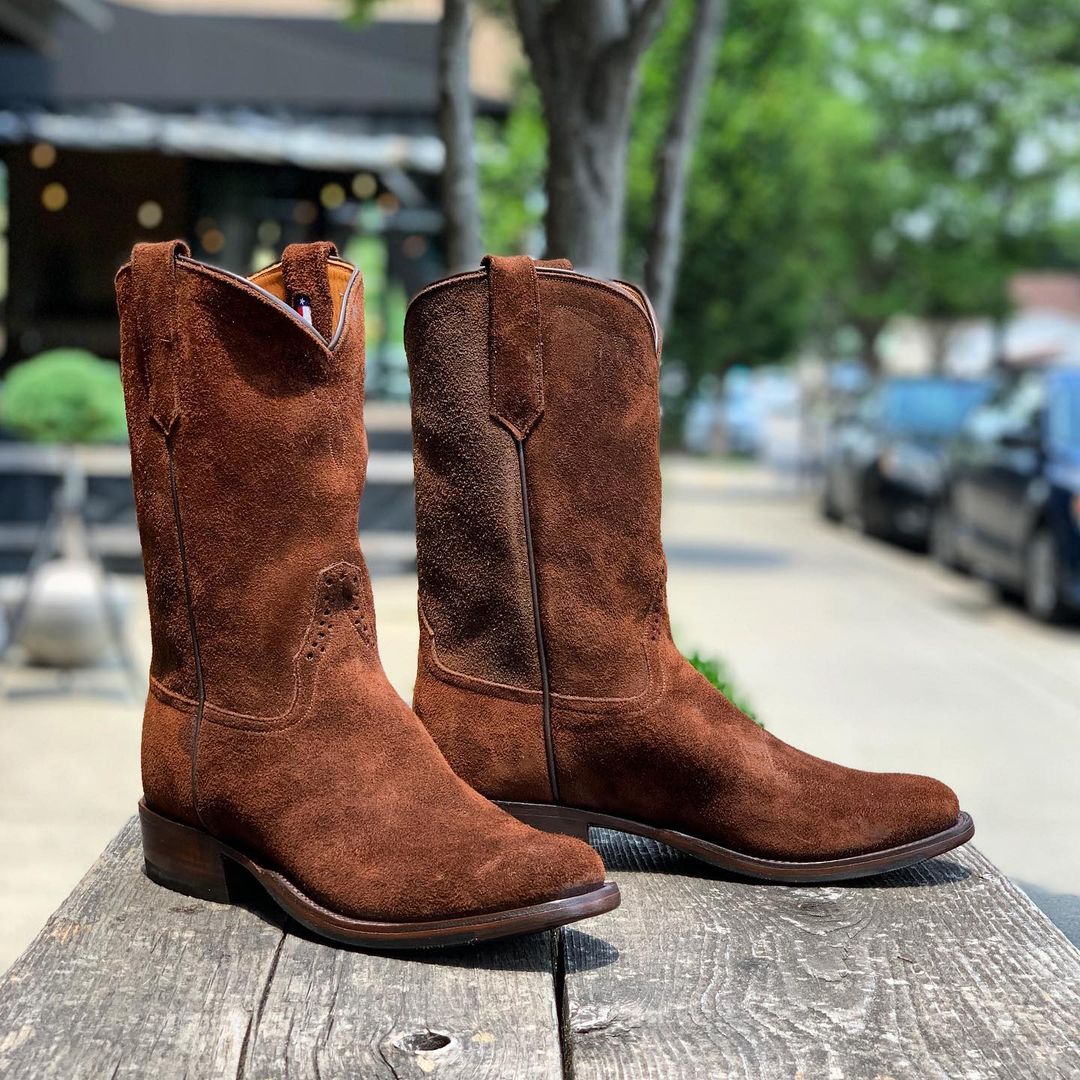
- Tecovas
- Ranch Road
- Lucchese
- Rios of Mercedes
- Heritage Boot Company
- JB Hill
Where to Shop
One of the challenges of buying cowboy boots is knowing where to turn. The world of Western boots is vast and diverse, with companies making things from unidentifiable petroleum products and high-end leathers. Here are some companies that I like:
Tecovas: The Meermin of the Western boot world and one of the best in terms of value. Affordably priced at around $250, these boots are made from full-grain leather, and the bottoms can be easily re-soled when necessary. The soles are attached using a partially sewn, partially lemonwood-pegged construction, as is traditional for Western boots. The designs are classic and subtle, and slot in well with most wardrobes. I like the Stockton in clay bovine, Cartwright in bourbon calf, Shane in honey suede, and Dean in midnight calf.
Ranch Road Boots: A relatively new boot company founded by a USMC veteran and Harvard Business School graduate who grew up in Texas. These boots have a contemporary flavor that will appeal to people who don’t want to go “full Tony Lama.” The Gunner and Bexar are tasteful roper styles that sit somewhere between the dressiness of an RM Williams Craftsman Chelsea and the ruggedness of a Red Wing Pecos roper. The Capistrano is a similar boot, but with a higher shaft and sharper toe. The Johnny is the company’s side-zip. These boots are made in Spain using full-grain leathers and Goodyear welt construction. A portion of every sale also goes towards supporting injured Marines.
Lucchese: One of the more respected names in the cowboy boot world. I’m not crazy about the styles where the uppers have been heavily painted with a faux patina, but the Bart is handsome. The company also makes a suede side zip called the Jonah, which has been popular with some men’s style enthusiasts in the last few years. Unlike Tecovas and Ranch Road, Lucchese’s boots are made in the USA.
Rios of Mercedes: An American heritage company with over 160 years under its belt, Rios of Mercedes produces everything at its own factory in South Texas. They have slightly wilder designs than what you’ll find from Lucchese, but are still very rooted in a traditional Western boot look. I prefer the more subtle ropers, such as the models you see at Planet Cowboy (the brown suede one pictured above is *chefs kiss*). Fortela also has some exclusive models with unique decorative stitching and suede-calf combination uppers.
Heritage Boots: Part artwork, part footwear. Heritage Boot Company sells retro-modern cowboy boots with distinctive toe shapes and wildly decorated shafts. After wearing a subtle roper for a while, you may find yourself at this site, admiring models such as the Sagebrush, Camel Ranch Hand, Happy Texas, Cactus & Shark, and Badlands.
JB Hill: Extremely tasteful, high-end leather cowboy boots. The company specializes in custom-made boots that will appeal to footwear enthusiasts and those who have a hard time fitting into ready-to-wear. You can either meet them at one of their trunk shows, visit them at their office, or do a remote order (they have “fitter boots” that can help nail down your size). I like the Breaux, 850, and Sonoma. Since they offer custom-made boots, you can create your own designs using their options for leather, toe shape, and stitching patterns. These are the sorts of boots I imagine in a “country gentleman’s closet.” During the workweek, he’s in gabardine suits; on the weekend, he’s in these boots.
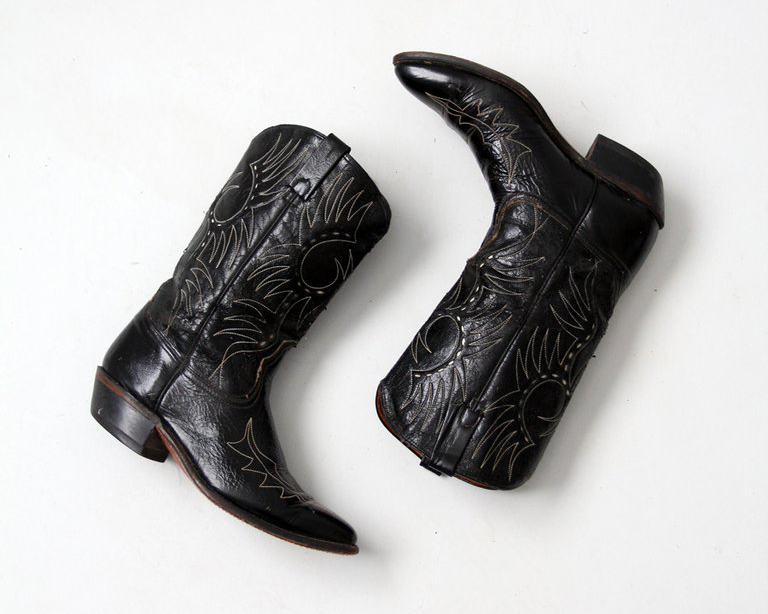
- Red Wing
- Yuketen
- Graham Ebner
- Savas
- Barbanera
- Acme
Red Wing: The old Red Wing Pecos was popular with denimheads back in the day. You can see a peanut-colored suede version on Kapital photographer Eric Kvatek. Unfortunately, Red Wing discontinued the model and replaced it with something not as great. However, you can find something similar in the Nailseat. This rugged, pull-on roper looks excellent in any workwear outfit.
Yuketen: Yuketen’s Pedro roper is the company’s answer to the long-lost, much-missed Red Wing Pecos. Like the Pecos, this rough, pull-on roper will fit into any workwear outfit. If you get a suede pair, add a suede protectant, and these can double as light rain boots.
Texas Traditions: Among the best of the best. Texas Traditions is run by Lee Miller, who trained under the legendary Charlie Dunn. This tiny workshop makes entirely handcrafted, bespoke cowboy boots — truly handcrafted — but you have to be able to fly to Austin, Texas to be measured and fitted. Kirby Allison has a multi-part video series about the company. Check out some of their iconic designs.
Graham Ebner: A cowboy boot maker at Texas Traditions who’s able to take independent orders. However, like with Texas Traditions, you have to be able to fly to Austin, Texas to get measured and fitted. Each pair of boots is fully handmade and bespoke.
Barbanera: This Italian company started with dress shoes, but has since moved into ready-to-wear apparel. Their style sits at the crossroads of 1970s sleaze, rock ‘n roll, and Westernwear. It’s basically American Western-style as imagined by the three Italian founders — romantic, sexy, and very masculine. They have a couple of cowboy boot styles — the Cash and Cormac — which are built on a dress shoe last. Since the shaft is built with a back zipper, it fits slimmer and can work with very slim jeans.
Savas: Savas’ Legend boot isn’t really a cowboy boot. Company founder Savannah Yarborough describes her company as “tasteful rock ‘n roll,” which I think is a much more apt description for this weathered, back-zip style. But they have great texture, can work with most of the outfits mentioned above, and show how close you can get to a Western boot without actually owning one. This gasoline-colored Legend boot would look tremendous with black jeans, a Western denim shirt, and a tan suede trucker jacket.
Vintage: There’s something charming about the look of well-worn cowboy boots. That patina can be difficult to achieve on your own if you’re a cubicle farmer and Dorito Rancher like me. If you’re looking for something used, scour eBay, Etsy, and thrift stores for names such as Acme and Justin. The Acme Pee Wee was a fashionable boot in the 1940s and ’50s. Made with fanciful stitching and inlaid leathers, it combines excellent construction with a retro-styled design that can be difficult to find today.
